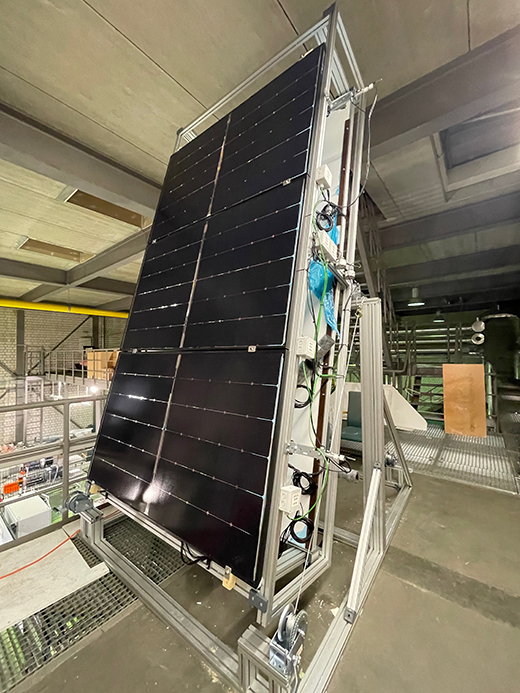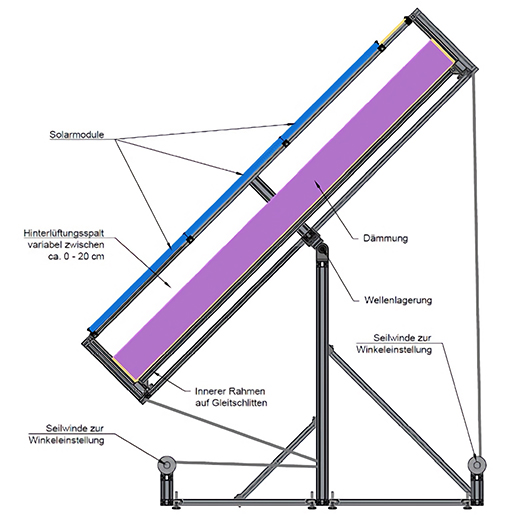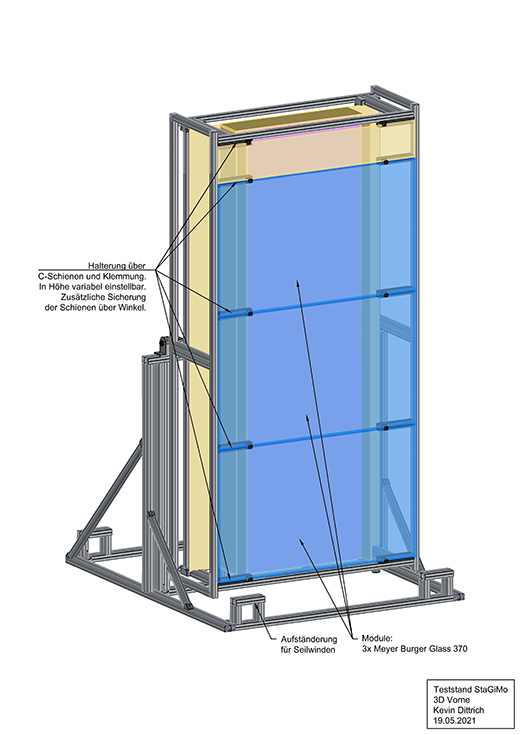- Products
- Solutions
- Service
- Company
As part of the StaGiMo research project, the Department of Energy and Information at HTW Berlin built a test station to investigate the optimum rear ventilation distance for PV modules - and benefited from the flexibility of the MiniTec modular profile system.
Photovoltaics in the building sector is booming without end. In addition to the traditional installation of modules on roof tiles (on-roof systems), the power generators are also increasingly being used on facades and as a direct roof surface - without tiles (so-called in-roof modules).
With normal façade cladding, sufficient rear ventilation is required to remove moisture due to condensation etc. so that mold does not form in the insulation. This is also important for PV modules on façades, where the air flow also ensures a reduction in temperature - and therefore a higher yield. On average, only 20 percent of solar energy is converted into electricity, the rest is converted into heat.
The hotter the PV modules, the less efficient they are. Adequate spacing is therefore doubly important. However, there are constructional restrictions. The roofing guidelines and the professional association for rear-ventilated façades specify a minimum distance, and there is also a maximum distance for rear-ventilated façades with metal substructures.
The Department of Energy and Information at HTW Berlin has set itself the goal of determining the optimum rear ventilation distance for façade and in-roof modules. A test station was therefore constructed based on the MiniTec profile construction kit, which is suitable for both areas of application. The test surface had to be able to be tilted as required from the vertical (façade) to a roof with different slopes.
Prof. Dr.-Ing. Susanne Rexroth, head of the sub-project at HTW Berlin, explains the concept: "We are testing and measuring the influence of the rear ventilation distance on the flow velocities and how the heat is then transported away. The aim is also to use the initial tests to determine how the test stand itself can be further developed. It is a prototype that is constantly being revised and optimized. The MiniTec modular profile system is the ideal design basis for this because it makes it very easy to make frequent changes."

The Department of Energy and Information at HTW Berlin is using a test setup to determine the optimum rear ventilation distance for PV modules.
The design was carried out by HTW using CAD software. The results were imported into MiniTec's iCAD Assembler to generate the automatic parts list. "That was very helpful. We then sent the parts list to MiniTec and the finished parts were delivered to us quickly. They were a perfect fit. We had initially considered sawing the profiles ourselves, but we wouldn't have been able to do that so accurately," explains Ingo Wiederoder, project employee and project coordinator.
In principle, MiniTec could also have built the entire system, but this was not necessary due to the HTW's extensive experience with the system, says Wiederoder: "Although it was the first time for us as a team, there are countless laboratory test facilities and similar systems based on MiniTec in other courses at the HTW. That's why the lab engineers are very familiar with it."

Design of the measuring stand with functional explanation.
The station is about 3.60 m high. 45 mm profiles are used for the substructure and 30 mm profiles for the frame itself (for weight reasons).
The frame construction consists of an outer frame to which the solar modules are attached and an inner frame to which the insulation is attached. The entire frame is pivoted on a stand. The inner frame can be moved using sliding carriages. This allows the distance from the insulation to the solar modules to be varied.
The entire façade can be tilted as the frame construction is mounted on two shafts. The angle of inclination is adjusted and fixed using four cable winches, which are attached to the corners of the stand. The solar modules on the frame are freely interchangeable.
The insulation was designed as EPS insulation. The rear ventilation space is sealed off from the surroundings by HPL panels and foil. Like the modules used, the corresponding substructure is freely selectable and is mounted in the rear ventilation space without a load-bearing function.
To simulate solar radiation, the HTW experts apply current to the modules so that they heat up. The process is similar to electroluminescence tests on PV modules, which are used to diagnose invisible damage.
The station is equipped with numerous sensors to measure temperature and lift current. There are also sensors on the modules (six per module), as well as on the insulation, where two air flow sensors at the top and bottom measure how the air is flowing. At the back of the test stand is a box with a server that records all the measurement data. The results can then be downloaded via WLAN in CSV format for further processing.
Ingo Wiederoder describes the particular advantages of the indoor test stand: "Until now, tests like this have only been carried out outdoors. If we can also achieve reliable results indoors, that would be a major step forward because we would then be independent of the weather. We would also be able to create reproducible conditions. We always have a relatively constant room temperature. There are no day and night phases, no seasonal differences.
We also have no wind blowing onto the test stand from outside, which would swirl the air flow behind the ventilation and distort the measurement results. We can now optimally determine what kind of air flow develops when the modules heat up."

Do you need a suitable solution or an approach for your project? Then get in touch with us!